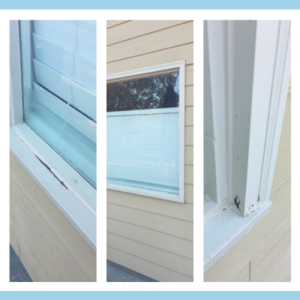Rotten Exterior Wood Trim

The Problem
I have lived in my house in Baton Rouge, La for over 20 years. One thing that has been as consistent as hot weather, fire ants, and mosquitoes is rotten exterior wood. I can usually expect to replace a section of rotten soffit and facia about every 2-3 years! The problem areas are always on the back of the house or garage, which faces east. I have spent 20 years trying to figure out the cause of the moisture intrusion. My overhang is good, roof and drip edge are both fine, and there are no problems when I look inside the attic.
This week I had a new problem on the back side of my house. The exterior trim around my master bathroom window has severe wood decay. This trim is known as “brick molding” even though my house has Masonite siding. So, my new project will be to fix this between the frequent rain showers.
The Cause
If the rotted wood was on the inside of the house, I would blame condensation as the problem. When cold weather sets in, condensation can appear on windows and sliding glass doors. This is sometimes called “sweaty windows.” The condition is the result of high humidity inside the house and low temperatures outside the house. Window condensation is simply the result of excess humidity, and the glass only provides a visible cool surface on which humidity can condense. Humidity will condense on any window if conditions are right regardless of the window manufacturer or whether the window is made of wood, vinyl, or aluminum.
My window has never shown condensation on the inside, and window sill on the inside is in fine condition. So, what caused the wood to decay on the outside? If you look at the pictures you will see that the bottom horizontal piece (the sill) is flat. Rain falls on the sill and slowly evaporates rather than quickly run off if the sill were slightly tilted outward. Also, the roof overhang keeps the sill under a shadow for most of the day which slows drying. The two vertical pieces are rotted at the joint with the sill. This is due to water wicking upward, against gravity, from an area of high concentration (the sill) to an area of low concentration (the vertical pieces), which is known as diffusion.
The Solution
There are numerous possible solutions to this problem. I am going to slightly tilt the new sill downward and outward. If that does not work, I will come back with a treated wood solution.
Craftmaster Manufacturing, Inc produces an exterior wood trim with excellent decay resistance. The company was recently acquired by Jeld-Wen, which is one of the largest window and door manufacturers in the world. The CraftMaster products contain environmentally friendly wood borate-based preservatives.
In addition, research at Mississippi State University has identified an alternative procedure for obviating the effects of water penetration at openings in the exterior walls of structures and has been developed and patented (United States Patent #7,195,823). The technique utilizes a fibrous pad that is impregnated with a water-diffusible biocide (usually borates). By placing the pads either on the portions of windows/doors adjacent to framing or on the surrounding framing, the water intercepted by the pads solubilizes the biocide which then diffuses into the adjacent wood to protect/preserve it. One feature of this technology is that it allows for periodic reapplication of the biocide. Borates are a safe and economical wood preservative with a proven record of high efficacy. Leaching is not a problem because the wood is not in ground contact.
Meet the Author
Dr. Todd Shupe is the President of Wood Science Consulting, LLC. He is a well-recognized expert on wood forensics, wood preservation, wood decay and degradation, and wood species identification. He has a broad background in new product development, quality management, and marketing and sales in both the public and private sectors. For more information please visit DrToddShupe.com.
We welcome your comments below.
Thank you for visiting. We trust that you have enjoyed reading our articles.
Liked this post? Read more below or search for more topics . . .

